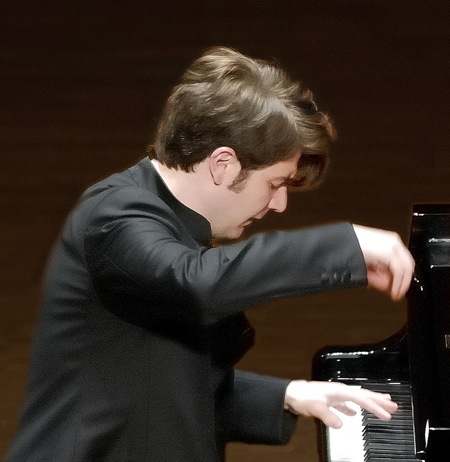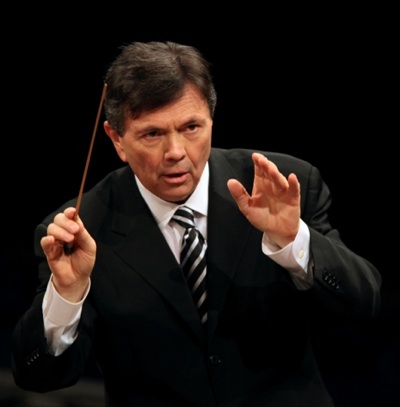Resilience and depth at Zellerbach
Under the gentle ministrations of a top conductor, the Berkeley Symphony pulled off an entirely satisfying concert last Thursday with a performance of Rachmaninoff’s Piano Concerto No. 2 that would have been the envy of any major orchestra, along with a provocative premier and a surprisingly tender Wagner.
 After their regular conductor, Joana Carneiro, was unable to fly from Lisbon, Executive Director Rene Mandel called upon Gerard Schwarz as a last minute replacement for the season-opening concert. Schwarz, recently retired from the Seattle Symphony and current conductor of New York’s All Star Symphony, just finished a wrap on eight episodes of great works performed by top musicians from across the country, scheduled to air here soon on KQED.
After their regular conductor, Joana Carneiro, was unable to fly from Lisbon, Executive Director Rene Mandel called upon Gerard Schwarz as a last minute replacement for the season-opening concert. Schwarz, recently retired from the Seattle Symphony and current conductor of New York’s All Star Symphony, just finished a wrap on eight episodes of great works performed by top musicians from across the country, scheduled to air here soon on KQED.
It is always illuminating to see other conducting styles, as each conductor brings out a unique vision. In an interview before the concert, Schwarz mentioned that, as a young musician, he took part in the Mitropoulis Competition, where five different conductors evoked five entirely different sounds from the orchestra.
Schwarz’ conducting was fine-grained: relaxed, structured and communicating an expectation of excellence. They opened with The Ossicles by Edmund Campion, a difficult new work jointly commissioned by the Berkeley Symphony and Cal Performances.
After hearing Campion’s premiere with the Santa Rosa Symphony last year for orchestra, Kronos Quartet and electronics, I was surprised by the lack of electronics here. But many of his textures seemed to derive from an approach outside of the instrumental. In fact, the subject itself could be mistaken for an analytical scrutiny of vibration: the Ossicles of the title are the three bones that transmit sound from the eardrum to the hairs of the inner ear. Each movement, named after one of these tiniest of bones, developed a curious blend of the literal and the poetic.
Concertmaster Franklyn D’Antonio began Malleus (Hammer) with a spider silk thread of sound. Then a soft drum of strings and horns, a long whoosh of ball bearings sliding between thin membranes, and a slow wah-wah of string tremolos accelerated the movement into frenzy.
Incus (Anvil) was even more literal, with violins developing a perpetuum mobile, a nervous rush like the beat and feedback of one’s own blood when ear is pressed to seashell. And then hammer blows to an anvil (or brake drum) punctuated big chords stretched across the octaves. The tiniest bone, the Stapes, called for the cool blend of muted strings and French horn breaths, then built to an exotic pairing of extremes—pianissimo trombone bass notes with a stratospheric violin note, like that on which they entered.
This was all about the breadth and texture of vibration, and Campion shows us poignant contrasts: brass mumbles and the low crackle of paper; bass pizzicatos spiced with the “tink” of cymbal; trombone harrumphs joining the peremptory clack of wooden blocks.
After a dreamy rendition of Wagner’s Siegfried Idyll, complete with some grand brass work, came Rachmaninoff’s colossal return to Romanticism, his Piano Concerto No. 2. Italian piano wunderkind Alessio Bax came to interpret it for us, with a depth that was extraordinary. Written while Rachmaninoff was wrestling with his personal demons, its emotional gamut runs from brooding to ecstatic, a celebration of Russian contradictions. Bax may have performed the single best rendition I have heard, balancing despair with passion while never dawdling over it.
The Berkeley Symphony swept in with stern Russian modal, all fat strings and grand gestures. Alex Camphouse excelled on French horn (and took a bow after the Wagner), and the wind solos were all one could ask for, led by Roman Fukshansky on clarinet, Emma Moon on flute, and Kyle Bruckmann on oboe. The entire viola section deserves to be commended for their many fine moments.
A word with the conductor
Schwarz, of course, also deserves much credit.
 I had the opportunity to talk to him earlier in the day, just before their final rehearsal. After 26 years as Artistic Director of the Seattle Symphony, and two years prior to that as principle conductor, Schwarz left the Northwest for an opportunity to put together his All Star Symphony. In person he is as gracious and thoughtful as on the podium.
I had the opportunity to talk to him earlier in the day, just before their final rehearsal. After 26 years as Artistic Director of the Seattle Symphony, and two years prior to that as principle conductor, Schwarz left the Northwest for an opportunity to put together his All Star Symphony. In person he is as gracious and thoughtful as on the podium.
“Now that you have left Seattle, what are you up to?”
“I’m guest conducting a lot [around the world] and just finished recording eight episodes with the All Star symphony. Now we’re gearing up to record our second season. And I’m starting to compose more… I started out in composition, studying with Paul Creston while still in High School. And then at Juilliard I studied with Sessions and Milton Babbit and Persichetti.”
“As your All Stars are all great musicians, how do you create a [non-soloist] ensemble?”
“It’s picking the right people. Many of them are chamber musicians, not just first chairs. And they really listen. None of them are novices—they’ve played this music many times. When we recorded Daphnis and Chloe the focus and dedication were unbelievable. How many rehearsals do you think we get?”
“Four?”
“No. None. We go in and run it twice. And there are cameras everywhere… There is so little live classical music on television, and there is a demand for so much more. They ran this series on Friday nights in Seattle and it was among the top watched broadcasts each week.”
“In your broadcasts you pair older master works with recent?”
“Yes. In the last year at Seattle I commissioned 18 works from living composers.”
“And your series begins with pairing Philip Glass with Beethoven. Why?”
“The big gestures and development… and the rhythms [of sixteenths]. Philip is a friend.”
“You’ve recorded all of the Mahler Symphonies. What do you think of Michael Tilson Thomas’s recordings [of Mahler]?”
“He’s quite good… But I’m Austrian.”
—Adam Broner
Photo top of Alessio Bax; bottom of Gerard Schwarz, photo by Steve J Sherman.
